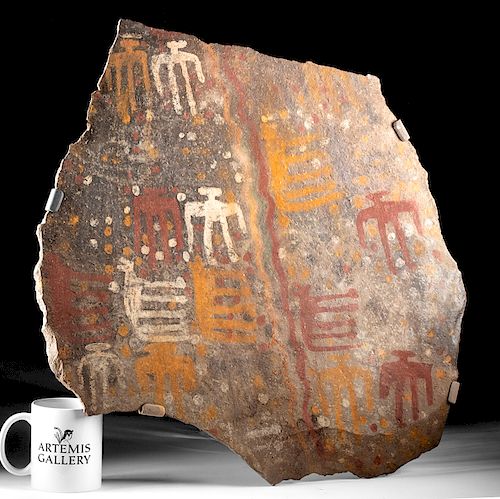Huge Inca Chucu Painted Stone Petroglyph Plaque
Lot 41
About Seller
Artemis Fine Arts
686 S Taylor Ave, Ste 106
Louisville, CO 80027
United States
Selling antiquities, ancient and ethnographic art online since 1993, Artemis Gallery specializes in Classical Antiquities (Egyptian, Greek, Roman, Near Eastern), Asian, Pre-Columbian, African / Tribal / Oceanographic art. Our extensive inventory includes pottery, stone, metal, wood, glass and textil...Read more
Estimate:
$15,000 - $20,000
Absentee vs Live bid
Two ways to bid:
- Leave a max absentee bid and the platform will bid on your behalf up to your maximum bid during the live auction.
- Bid live during the auction and your bids will be submitted real-time to the auctioneer.
Bid Increments
| Price | Bid Increment |
|---|---|
| $0 | $25 |
| $300 | $50 |
| $1,000 | $100 |
| $2,000 | $250 |
| $5,000 | $500 |
| $10,000 | $1,000 |
| $20,000 | $2,500 |
| $50,000 | $5,000 |
| $100,000 | $10,000 |
| $200,000 | $20,000 |
About Auction
By Artemis Fine Arts
Oct 3, 2019
Set Reminder
2019-10-03 10:00:00
2019-10-03 10:00:00
America/New_York
Bidsquare
Bidsquare : Exceptional Day 2: Pre-Columbian & Tribal Art
https://www.bidsquare.com/auctions/artemis-gallery/exceptional-day-2-pre-columbian-tribal-art-4453
Day 2 of an important 2-day auction featuring exceptional, museum-worthy examples of Pre-Columbian from the ancient Americas, Native American, African / Tribal, Oceanic, Spanish Colonial and fossils. Artemis Fine Arts info@artemisfinearts.com
Day 2 of an important 2-day auction featuring exceptional, museum-worthy examples of Pre-Columbian from the ancient Americas, Native American, African / Tribal, Oceanic, Spanish Colonial and fossils. Artemis Fine Arts info@artemisfinearts.com
- Lot Description
Pre-Columbian, southern Peru, Inca hinterlands (Chucu), ca. 1000 to 1500 CE. An enormous plaque made from light-grey shale, of an oblong form, and decorated with an intricate decorative program in painted hues of marigold, light teal, vermilion, dark-grey, and white with a hint of pink. The scene portrays a gathering of abstract human figures standing amongst a field of zoomorphic creatures, perhaps livestock like llamas, alpacas, or goats. Each animal exhibits four slender legs, a narrow body, and a petite head with tab-shaped ears, and the humans have wide ovoid heads, broad shoulders, rod-form arms draped next to squat abdomens, and lengthy legs. A wavy stripe of red, yellow, and teal pigment bisects the two halves of the decoration and perhaps represents a river or flowing channel of water along which both farmers and livestock lived. Petroglyphic plaques like this example are typically created from large fragments of pottery, so one made of stone like this example is of exceptional rarity! Size: 20.75" W x 20.25" H (52.7 cm x 51.4 cm).
Plaques like this example, made from either pottery or stone, have been discovered in a number of different contexts: beneath wall foundations, in graves, with animal sacrifices, and cached in prominent places in the landscape, like in springs, rock hollows, and atop hills. They are often discovered in pairs, with the painted surfaces placed so that they are facing each other, sometimes wrapped in leaves or even gold sheet. Although the tablet tradition began centuries before, the time period that this one comes from represents the height of the artform, and corresponds to an intensification of agriculture, the rise of interregional trade networks, and the ascendancy of certain important confederations of clans. Into this potent mix, the Inca expanded into the region and the tablet tradition abruptly ended. It seems likely that the Inca, who colonized regions in part by sponsoring local ritual activities, outlawed the creation of religious tablets like this because they saw them as a threat to their trade in sacrificial alpacas, corn beer, and cloth.
Provenance: private Hawaii, USA collection; ex-private Hillberg collection, California, USA
All items legal to buy/sell under U.S. Statute covering cultural patrimony Code 2600, CHAPTER 14, and are guaranteed to be as described or your money back.
A Certificate of Authenticity will accompany all winning bids.
We ship worldwide and handle all shipping in-house for your convenience.
#146789This is a fragment of a larger stone plaque. Nicks and abrasions to obverse, peripheries, and verso, with fading and chipping to areas of original pigmentation, and light encrustations. Nice earthen deposits throughout and fabulous traces of original pigment across obverse. Mounted on verse with modern metal bracket for display purposes.Condition
- Shipping Info
-
All shipping is handled in-house for your convenience. Your invoice from Artemis Gallery will include shipping calculation instructions. If in doubt, please inquire BEFORE bidding for estimated shipping costs for individual items.
-
- Buyer's Premium



 EUR
EUR CAD
CAD AUD
AUD GBP
GBP MXN
MXN HKD
HKD CNY
CNY MYR
MYR SEK
SEK SGD
SGD CHF
CHF THB
THB














